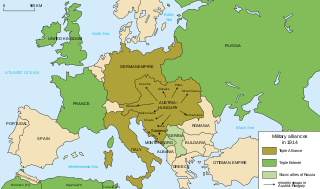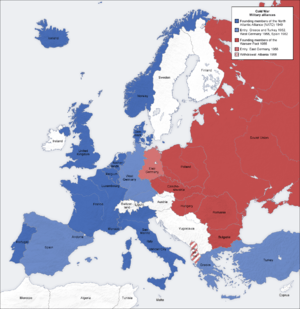Military alliance
A military alliance is an international agreement concerning national security in which the contracting parties agree to mutual protection and support in case of a crisis that has not been identified in advance.[1] Military alliances differ from coalitions, which formed for a crisis that already exists.[1]


Military alliances can be classified into defense pacts, non-aggression pacts, and ententes.[2] Alliances may be covert (as was common from 1870 to 1916) or may be public.[3]
Characteristics
Military alliances are related to collective security systems but can differ in nature. An early 1950s memorandum from the United States Department of State explained the difference by noting that historically, alliances "were designed to advance the respective nationalistic interests of the parties, and provided for joint military action if one of the parties in pursuit of such objectives became involved in war." A collective security arrangement "is directed against no one; it is directed solely against aggression. It seeks not to influence any shifting 'balance of power' but to strengthen the 'balance of principle.'"[4]
The obvious motivation in states engaging in military alliances is to protect themselves against threats from other countries. However, states have also entered into alliances to improve ties with a particular nation or to manage conflict with a particular nation.[5]
The nature of alliances, including their formation and cohesiveness (or lack thereof), is a subject of much academic study past and present, with the leading scholars generally considered to be Glenn Snyder and Stephen Walt.[6]
According to a 2019 study, almost all alliances to 1870 to 1916 were covert. In other time periods, covert alliances have been rare. The study argues that from 1870 to 1916, the unusual amount of covert alliances was incentivized by other covert alliances. The creation of public alliances would signal to the covert ally that the public alliance was more valuable.[3]
European historiography
In the European historical context, a military alliance can be viewed as a league between independent states, defined by treaty, for the purpose of combined action, defensive or offensive, or both. The oldest such alliance in the world today is the Anglo-Portuguese alliance, dating back to 1373 where the then Kingdoms of England and Portugal pledged to "perpetual friendship" between the two countries. This remains in action today between the current United Kingdom and Portugal, and the two have never fought against each other in any military campaign. Alliances have often been directed to specific objects carefully defined in the treaties. Thus the Triple Alliance of 1668 between Great Britain, Sweden and the Netherlands, and the Grand Alliance of 1689 between the Holy Roman Empire, Holland, England, Spain and Saxony, were both directed against the power of Louis XIV of France. The Quadruple or Grand Alliance of 1814, defined in the Treaty of Chaumont, between Great Britain, Austria, Russia and Prussia, had for its object the overthrow of Napoleon and his dynasty, and the confining of France within her traditional boundaries. The Triple Alliance of 1882 between Germany, Austria and Italy was ostensibly directed to the preservation of European peace against any possible aggressive action of France or Russia; and this led in turn, some ten years later, to the Dual Alliance between Russia and France, for mutual support in case of any hostile action of the other powers.[7]
Occasionally, however, attempts have been made to give alliances a more general character. Thus the Holy Alliance of 26 September 1815 was an attempt, inspired by the religious idealism of the Emperor Alexander I of Russia, to find in the "sacred precepts of the Gospel",[7] a common basis for a general league of the European governments, its object being, primarily, the preservation of peace. So, too, by Article VI of the Quadruple Treaty signed at Paris on 20 November 1815 – which renewed that of Chaumont and was again renewed, in 1818, at Aix-la-Chapelle – the scope of the Grand Alliance was extended to objects of common interest not specifically stated in the treaties. The article runs: "In order to consolidate the intimate tie which unites the four sovereigns for the happiness of the world, the High Contracting Powers have agreed to renew at fixed intervals, either under their own auspices or by their respective ministers, meetings consecrated to great common objects and to the examination of such measures as at each one of these epochs shall be judged most salutary for the peace and prosperity of the nations and the maintenance of the tranquillity of Europe".[7]
It was this article of the treaty of the 20 November 1815, rather than the Holy Alliance, that formed the basis of the serious effort made by the great powers, between 1815 and 1822, to govern Europe in concert. In general it proved that an alliance, to be effective, must be clearly defined as to its objects, and that in the long run the treaty in which these objects are defined must – to quote Otto von Bismarck's somewhat cynical dictum – "be reinforced by the interests" of the parties concerned.[7] Yet the "moral alliance" of Europe, as Count Karl Nesselrode called it,[7] though it failed to secure the permanent harmony of the powers, was an effective instrument for peace during the years immediately following the downfall of Napoleon; and it set the precedent for those periodical meetings of the representatives of the powers, for the discussion and settlement of questions of international importance, which, though cumbrous and inefficient for constructive work, contributed much to the preservation of the general peace during much of the nineteenth century.[7]
Notes
- Bergsmann, Stefan (2001). "The Concept of Military Alliance" (PDF). Small States and Alliances. pp. 25–37. ISBN 978-3-7908-2492-6. ISBN 978-3-662-13000-1 (Online)
- Krause, Volker; Singer, J. David (2001). "Minor Powers, Alliances, And Armed Conflict: Some Preliminary Patterns" (PDF). Small States and Alliances. pp. 15–23. ISBN 978-3-7908-2492-6. (ISBN 978-3-662-13000-1 (Online)
- Kuo, Raymond (2019-05-16). "Secrecy among Friends: Covert Military Alliances and Portfolio Consistency". Journal of Conflict Resolution. 64: 63–89. doi:10.1177/0022002719849676. ISSN 0022-0027.
- Tucker, Robert; Hendrickson, David C. (1992). The Imperial Temptation: The New World Order and America's Purpose. Council on Foreign Relations. pp. 64–65.
- Weitsman. Dangerous Alliances. pp. 18–19.
- Byman, Daniel (October 2006). "Remaking Alliances for the War on Terrorism" (PDF). The Journal of Strategic Studies. 29 (5): 767–811. doi:10.1080/01402390600900887. Archived from the original (PDF) on 2016-03-04. Retrieved 2015-04-05.
- Phillips 1911, p. 695.
References

Further reading
- Liska, George (1968). Alliances and the Third World. Baltimore: Johns Hopkins Press.
- Pressman, Jeremy (2008). Warring Friends: Alliance Restraint in International Politics. Ithaca: Cornell University Press.
- Snyder, Glenn H. (1997). Alliance Politics. Ithaca: SCornell University Press.
- Walt, Stephen (1987). The Origins of Alliances. Ithaca: Cornell University Press.
- Weitsman, Patricia A. (2004). Dangerous Alliances: Proponents of Peace, Weapons of War. Palo Alto: Stanford University Press.